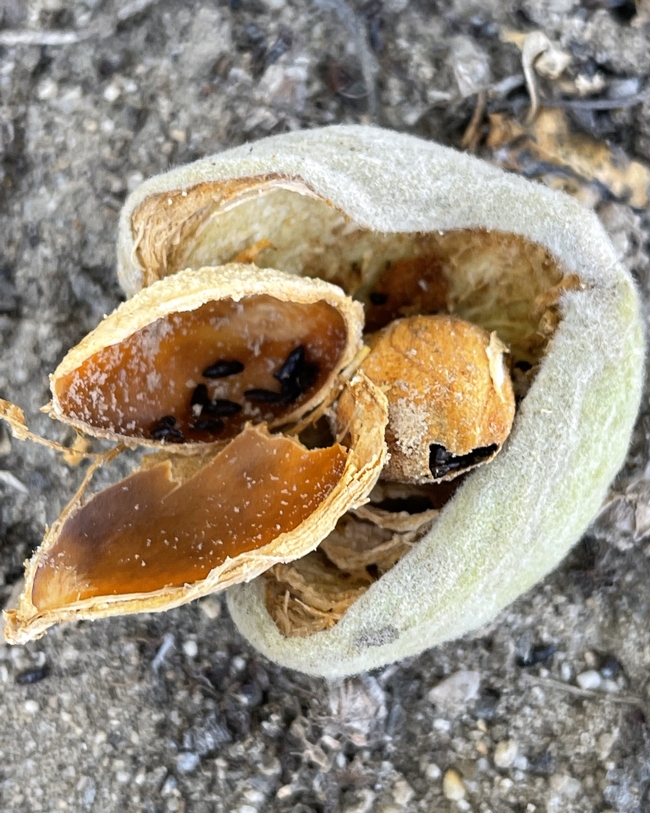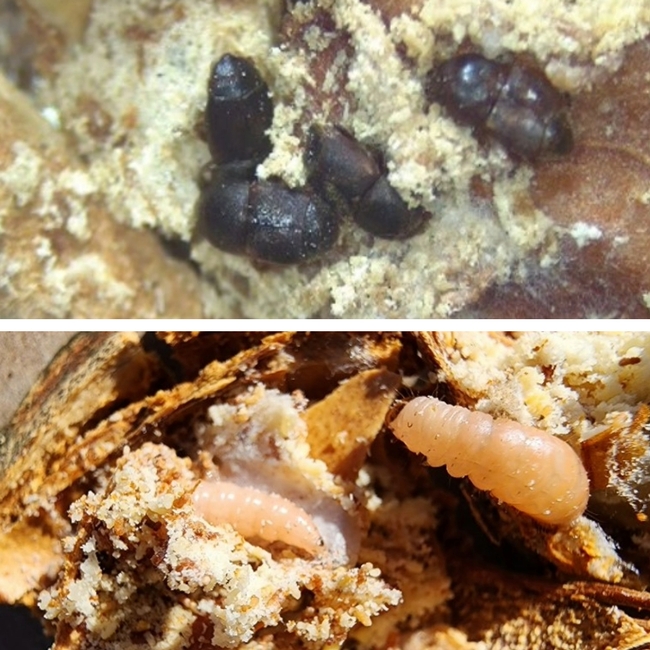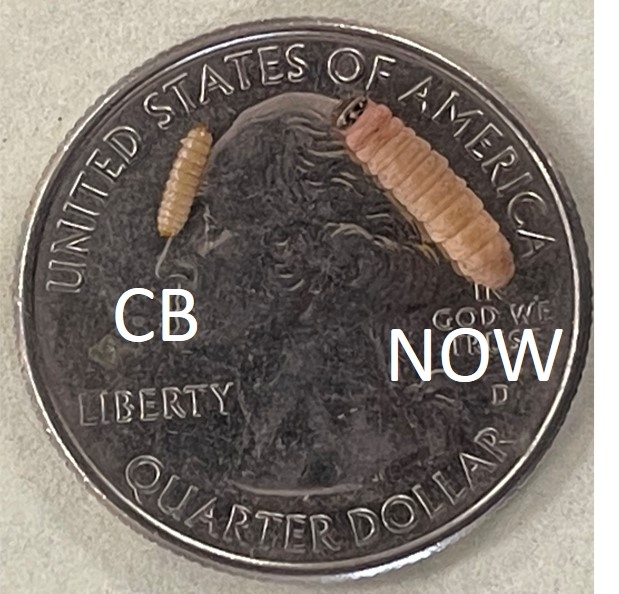
Posts Tagged: IPM
Celebrating the Crab Spider in Arachtober
It's Arachtober and that means celebrating arachnids for the entire month of October. Well, we ought to celebrate them year around, but October is THEIR month. Let's especially applaud crab spiders when they prey on such agricultural pests as the lygus bug, also known as the "western...
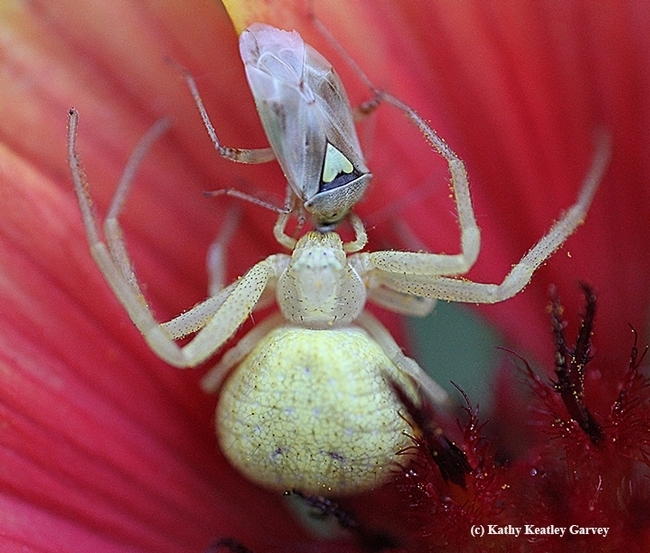
A crab spider eating a lygus bug, an agricultural pest in a Vacaville garden. (Photo by Kathy Keatley Garvey)
Visual ID guide from UC aids in managing new almond pest
Nut orchard hygiene key to control carpophilus beetle, say UCCE, UC Integrated Pest Management experts
Since the first reports of a new almond pest – the carpophilus beetle (Carpophilus truncatus) – came in during fall 2023, it has become clear that the beetle is widely dispersed across the San Joaquin Valley.
“My lab has identified infestations from every county in the San Joaquin Valley; we have found infestations in both almonds and pistachios, and we will likely find infestations in walnuts this fall,” said Houston Wilson, a University of California Cooperative Extension entomology specialist at UC Riverside. The California Department of Food and Agriculture has confirmed the beetle's presence in Stanislaus, Merced, Madera and Kings counties.
Historically a major threat to almond production in Australia, the beetle – as larvae and adults – feeds directly on the nut kernel. In California, some almond growers have lost 10 to 15% of their yield – a “significant economic loss,” according to Jhalendra Rijal, University of California integrated pest management (IPM) advisor for the region. Given the prominence of almonds as a commodity, even a 1% overall reduction statewide represents an approximately $70 million loss.
“This year there has been a lot more reports from PCAs [pest control advisers]; they're sending me the pictures of the damage and beetles,” said Rijal, noting that the increase is likely due to greater awareness of the pest.
To help almond growers identify the carpophilus beetle and develop management plans, Rijal, Wilson and their IPM colleagues have put together a visual ID guide for the beetle and the damage it causes, as well as telltale signs of navel orangeworm (Amyelois transitella) and ant damage. In particular, the experts would like PCAs and growers to differentiate between the carpophilus beetle and navel orangeworm, another key pest in almonds.
“Even though their way of causing damage looks more or less similar, we're dealing with two different types of insects,” Rijal explained. “One is a Lepidoptera moth [navel orangeworm], and the other one is a beetle – many of the management practices and biological controls would be different for these two different things.”
To control carpophilus beetle, ‘sanitize, sanitize, sanitize'
One crucial cultural practice for managing both pests, however, is destroying the remnant “mummy” nuts – the nuts that remain in the orchard postharvest. They serve as overwintering habitat for the carpophilus beetle, as well as its sustenance for the next generation of beetles in spring.
“The best way to manage this pest is to do the orchard hygiene – continuing the winter sanitation, destroying the nuts that are on the ground and on the tree and on the berms,” Rijal said.
Based on observations in Australia and locally, carpophilus beetles tend to rely more on mummies on the ground, whereas navel orangeworm generally favors mummies in the tree canopy. Correctly identifying the pest – with help from the new ID guide – enables growers to better target and prioritize their management efforts, Rijal said.
“What we are strongly emphasizing is that growers need to sanitize, sanitize, sanitize to control both pests,” Wilson added.
Correct identification of the pest would also prevent unnecessary application of insecticides, as those used for controlling Lepidoptera such as navel orangeworm would be largely ineffective on the beetle.
Indeed, another insight shared by Australian experts is that the carpophilus beetle cannot be controlled just by insecticide.
“Insecticides are not very efficient, given the cryptic nature of these beetles; exposing these beetles to the insecticide is very hard,” said Rijal, noting that the beetle spends most of its life cycle protected inside the nut.
Reporting carpophilus beetle infestation helps researchers
This harvest season, Rijal advises almond growers to harvest as efficiently as possible, to minimize the number of mummies that need to be cleaned up. And because signs of damage (like damaged hulls and frass) are most obvious during harvest time, Rijal said growers should review the new guide, using the photos and other resources to help identify potential pests.
If the grower or PCA suspects a carpophilus beetle infestation, they should contact the UCCE farm advisor in their area.
Scientists are looking to expand their knowledge about this relatively new pest to California. In the coming weeks, for example, researchers are planning to survey for the carpophilus beetle in the Sacramento Valley.
“Technically it has not been found there, but we suspect that we'll find it this fall when we go looking for it,” Wilson said.
Researchers are also collecting samples from infested orchards to better understand the biology of the species, as well as how it progresses through and responds to seasonal and climactic changes. In addition, they are analyzing data from a trial study of an insecticide that might be used as a supplemental control measure.
“This is our first full season dealing with this insect, and there are still many things we need to understand,” Rijal said. “We are continuing our research efforts on all fronts.”
Diagnosing herbicide problems takes detective work
Field day offers examples, tips for solving the mystery
A grower applies an herbicide to his tomato plants, or thinks a neighbor's treatment is drifting over her almond trees. A short time later, the leaves start to bleach or shrivel. Was it the herbicide? Or maybe water stress? Soil nutrients? Perhaps an insect?
Figuring out the causes of crop problems takes detective work, and like solving any mystery, it starts with knowing the signs, gathering evidence and asking questions.
The Diagnosing Herbicide Symptoms field day at UC Davis was an opportunity to see, up close, the shriveled cotton, scorched corn and dying sunflowers that can result when herbicides are applied incorrectly. Using the right herbicide – in the right proportion, at the right time and in the right field – can make the difference between a thriving crop and a financial loss.
A top take-away to avoid problems: “Don't do stuff at night!” laughed Becky Wheeler-Dykes, a UC Cooperative Extension farm advisor attending the June 26 event to better serve growers in Glenn, Tehama and Colusa counties. “The packages look the same. People grab the wrong jug.” And then, disaster.
Instructors were Brad Hanson, professor of Cooperative Extension; and Kassim Al-Khatib, the Melvin D. Androus endowed professor for weed science; both in the Department of Plant Sciences. They were joined by John Roncoroni, a Cooperative Extension emeritus farm advisor rooted in the department's weed science program. Attendees were a mixture of people from agriculture, industry, government officials, university researchers and Cooperative Extension advisors. The event was hosted by the Weed Research and Information Center, based in the Department of Plant Sciences.
Out in a field west of campus, visitors could see the progression of damage, from control plots with green and healthy crops to plants that looked sadder as herbicide concentrations increased. Visitors could see the patterns of damage for common foliar chemicals such as glyphosate, paraquat, and 2,4-D, as well as soil-applied herbicides from several chemical classes.
“There's a lot of detective work,” said Stephen Chang, a master's student in Hanson's lab aiming for a career in Cooperative Extension. “For example, the company that makes the herbicide says there shouldn't be a problem, but the grower says, there is a problem. This course helps with developing the skills to figure out what happened.”
It might not be the herbicide at all
Detective work and problem-solving frame the approach, Hanson explained. The cause of crop damage can be simple or complex. Like a good mystery, what appears to be a clue can turn out to be a red herring. Professionals need to draw on their inner Sherlock Holmes to observe and document symptoms, look for patterns in the plants and in the field, ask questions, gather information about the larger environment and collect samples.
An herbicidal Agatha Christie would then suggest: What if it's not herbicide damage at all? Participants learned to consider the possibility of insects, pathogens and viruses, as well as problems with water, nutrients, soil condition and even root damage from cultivation practices.
Hanson recalled puzzling over symptoms he found in an orchard. The culprit? “A leaking natural gas line,” he said.
More resources for herbicide issues
Participants also heard from Molly Mathews, deputy agriculture commissioner from Yolo County, on how a field investigation is conducted. Lawyer Robert Davies, of Donahue Davies LLP in Folsom, outlined the basics of what happens when there are lawsuits related to crop damage from herbicide drift.
The Diagnosing Herbicide Symptoms field day is part of a larger program of education and outreach offered through the Weed RIC, said director Julia Stover-Blackburn. It was the first time the event has been offered since the COVID-19 pandemic, she added.
- For more information about field days and resources, visit the Weed RIC webpage.
- For a thorough discussion of herbicide symptoms, visit this page overseen by Al-Khatib and sponsored by University of California Agriculture and Natural Resources.
- This online course follows an earlier version of the Diagnosing Herbicide Symptoms field program.
This story was originally published on the UC Davis Department of Plant Sciences website.
The Katydid Nymph Did
The katydid nymph did. It did appear in May. The UC Statewide Integrated Pest Management Program (UC IPM) tells us that katydid nymphs appear in our gardens in April or May. This little nymph was right on time, barely, as it surfaced in our Vacaville garden on May 28. The nymph, a...
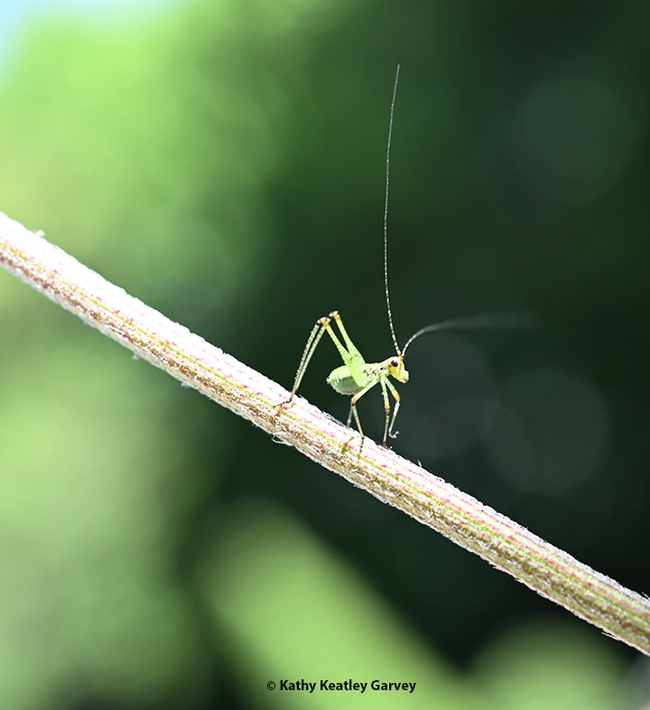
A katydid nymph, its long threadlike antennae upright, descends a stem in a Vacaville garden. (Photo by Kathy Keatley Garvey)
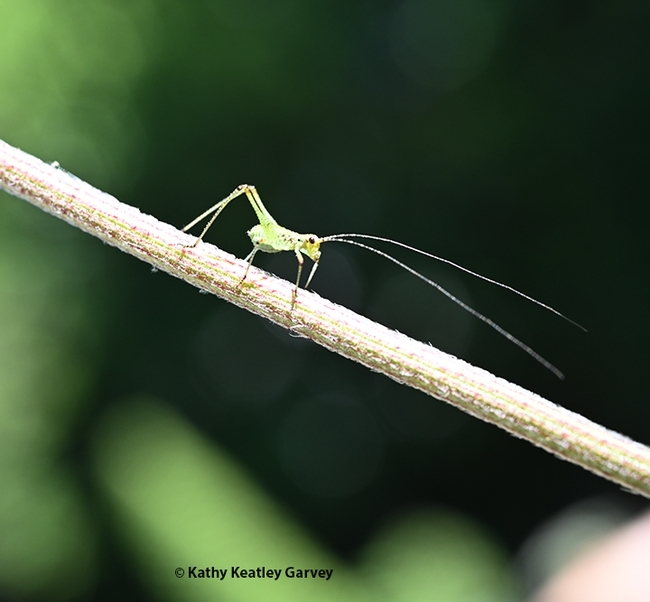
A katydid nymph, its long threadlike antennae upright, descends a stem in a Vacaville garden. (Photo by Kathy Keatley Garvey) The katydid nymph lowers its antennae and proceeds along the stem. (Photo by Kathy Keatley Garvey)
The katydid nymph lowers its antennae and proceeds along the stem. (Photo by Kathy Keatley Garvey)
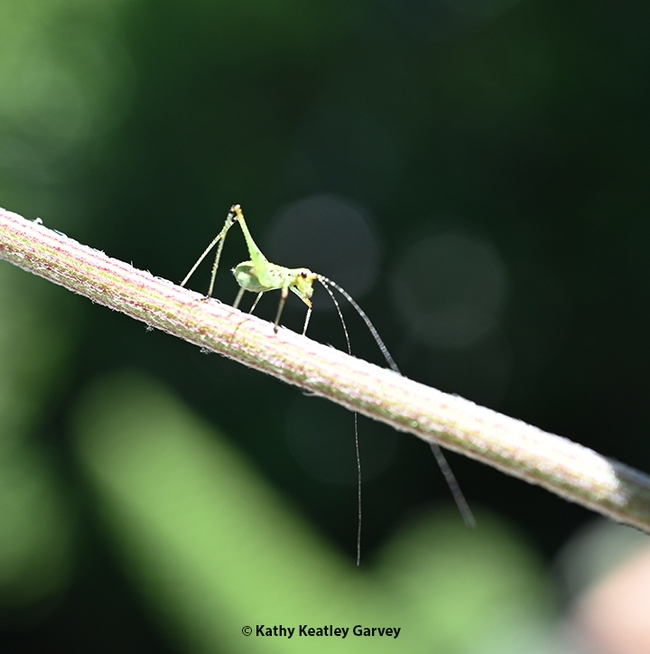
Antennae down, the katydid nymph continues its descent. (Photo by Kathy Keatley Garvey)
The Good Luck at UC Davis Picnic Day
Remember when San Francisco 49'ers wide receiver Brandon Aiyuk credited his spectacular 51-yard catch in the 2024 NFC championship game with the Detroit Lions to a ladybug (note that entomologists correctly call it a "lady beetle") landing on his shoe before the game? Well, those attending...
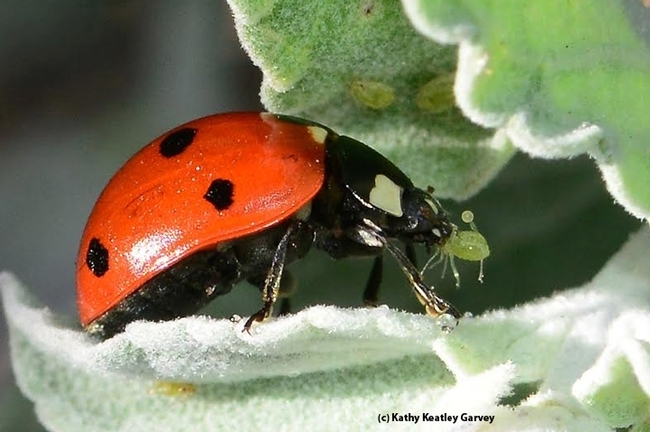
A lady beetle, aka ladybug, devouring on aphid on the UC Davis campus. (Photo by Kathy Keatley Garvey)
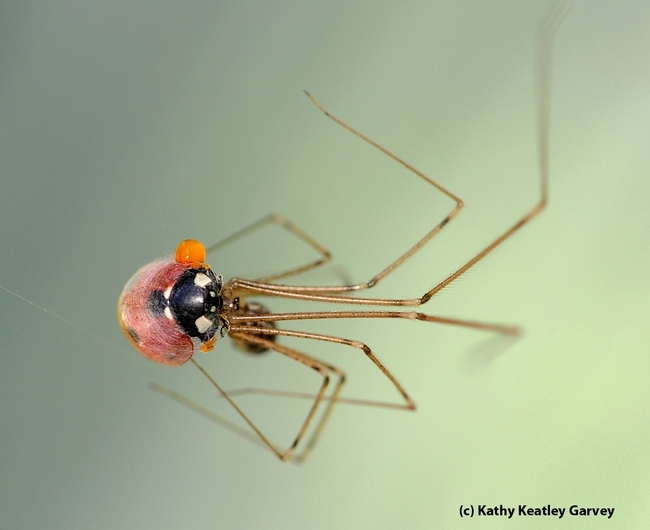
A cellar spider snares a lady beetle in a Vacaville pollinator garden. The red droplet is reflex bleeding, the beetle is emitting an alkaloid toxin to protect it from predators. (Photo by Kathy Keatley Garvey)

